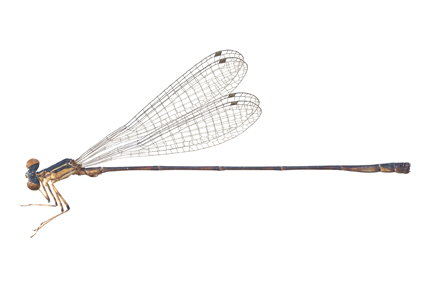Abstract
Epipleoneura parmula sp. nov. is described and illustrated based on males from eastern Ecuador (holotype: ♂, ECUADOR, Orellana Province, Primavera, Laguna Taracoa {0.4652°S, 76.7638°W}, 247 m, 27 July 1977, Dennis R. Paulson & Susan Hills leg., in FSCA). Using the most recent synopsis of the genus (Pessacq 2014), the new species keys to the couplet separating E. pallida Rácenis and E. ocuene De Marmels, but unlike in those species, the epiproct branches are longer, fused nearly their entire length and their tips are accentuated. Adults were collected at a lake and several ponds, indicating that the habitat is lentic, although the nymph is unknown.
References
- Dijkstra, K.-D.B., Kalkman, V.J., Rory, A.D., Stokvis, F.R. & Van Tol, J. (2014) Redefining the damselfly families: a comprehensive molecular phylogeny of Zygoptera (Odonata). Systematic Entomology, 39, 68–96. https://doi.org/10.1111/syen.12035
- Garrison, R.W., von Ellenrieder, N. & Louton, J.A. (2010) Damselfly genera of the New World: an illustrated and annotated key to the Zygoptera. The Johns Hopkins University Press, Baltimore, Maryland, 383 pp.
- Lencioni, F.A.A. (2005) Damselflies of Brazil. An illustrated identification guide. I. The non-Coenagrionidae families. All Print Editora, São Paulo, 324 pp.
- Pessacq, P. (2014) Synopsis of Epipleoneura (Zygoptera, Coenagrionidae, “Protoneuridae”), with emphasis on its Brazilian species. Zootaxa, 3872 (3), 201–234. https://doi.org/10.11646/zootaxa.3872.3.1
- Pessacq, P., Anjos-Santos, D., Carvalho, F.G., Calvão, L.B., Mendoza-Penagos, C.C. & Juen, L. (2022) A new Epipleoneura Williamson, 1915 (Zygoptera, Coenagrionidae) from northern Brazil and notes on E. venezuelensis Rácenis, 1955. Zootaxa, 5219 (2), 153–164. https://doi.org/10.11646/zootaxa.5219.2.4
- Rácenis, J. (1960) Cuatro nuevas especies del género Epipleoneura (Odonata: Protoneuridae). Acta Biologia Venezuelica, 3 (2), 25–42.


